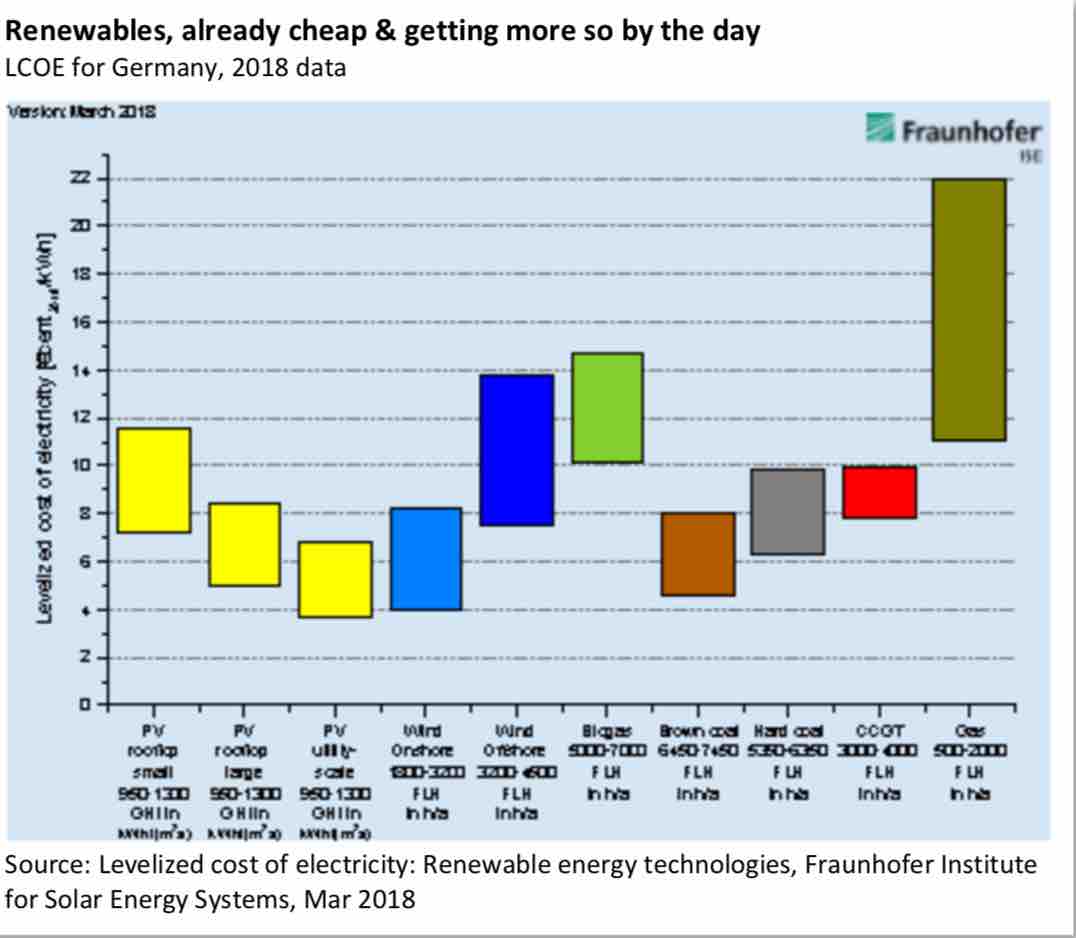One of the reasons the supremacy of oil may be challenged in the coming decades is the rapid rise of renewable energy resources, now on the verge of being the cheapest forms of energy, certainly in electricity generation.
A June 2018 study by Bernstein documents the persistent drop in the levelized cost of electricity (LCOE) from renewable generation over time with projections of where future cost reduction potential lies.
The report argues that the cost of onshore wind, offshore wind and solar power is likely to be well below the cost of fossil fuel generation nearly everywhere.
Few dispute such findings. Cheap and plentiful electricity supplies will make electrification of the global economies so much easier.
Similar results were reported in a March 2018 study from Fraunhofer Institute for Solar Energy Systems for Germany. According to the latest data, utility-scale solar PVs and on- shore wind are already the best options available based on the LCOE metric.
Prospects for off-shore wind are good with declining costs as the technology further improves and with mass scale investments. Offshore wind has higher capacity factors due to more persistent and steady offshore winds.
Studies such as these and others for other parts of the world increasingly reach similar conclusions, which explains the persistent growth of wind and solar on a global scale (visuals below).
Unsurprisingly, Fraunhofer is bullish on the continued rise of wind and solar and projects massive global renewable capacity additions under three scenarios considered, which are further described in its latest report.
As illustrated in the visual below (blue bars), global installed wind capacity, already around 550GW by end of 2017, has been steadily growing and shows little sign of slowing even if some of the subsidies are reduced or withdrawn over time.
In the meantime, solar capacity, which did not amount to much as late as a decade ago, passed the 400 GW milestone by end of 2017 and shows even more considerable growth potential (visual below, yellow).
Many sunny regions of the world, which have not invested in solar resources up to now, including the Middle East and parts of Africa, are now considering it.
Stand-alone off-grid solar, once considered expensive, exotic and impractical, is now expected to provide reliable, clean and sustainable electricity to populations without access to grid-supplied electricity.
According to an article in the 14 July issue of The Economist, these off- grid systems can illuminate the bottom billion – the estimated population without access to electricity.
Concentrated solar power (CSP) which was once promising, has lost momentum due to dramatic cost reductions in PV module prices (visual below, red inset). Ironically, it may experience a potential revival because it offers the option to take advantage of thermal storage, which is becoming a highly coveted feature totally lacking in solar PVs.

CSP may experience a resurgence in places where the peak demand occurs in the evening hours when solar PVs are not of much value after the sun sets.
Renewables are also making significant inroads at distributed level, mostly in the form of rooftop solar PVs, increasingly popular in sunny places with high retail tariffs and high percentage of detached homes with big roofs, such as in Australia (box).
With the expected fall in the cost of storage, Fraunhofer projects additional options for prosumers with solar PV systems (See Fig below). By adding distributed storage, they can become prosumagers, which gives them additional flexibility on when and how to generate, use or store energy – and perhaps trade with their neighbors – once that becomes possible.
The solar PVs + storage allows prosumagers to:
– Feed the excess generation into the grid if the prevailing conditions are favorable;
– Use the generated electricity for self-consumption; and/or
– Store the excess generation for use at later time when prices are more favorable.
In many parts of the world, the hybrid solar + storage is becoming popular, especially if the credit forfeeding excess generation into the distribution network through schemes such as net energy metering (NEM) or feed-in-tariffs (FiTs) are not as generous as they once were.
The batteries of electric vehicles (EVs) are among the options for storing the excess generation during sunny days.
As already noted, another promising solar option is concentrated solar power (CSP), which allows solar energy to be stored in thermal media, such as in molten salt, makes it possible for the power plant to continue operating after the sun has set.
This feature of CSPs offers a big advantage in places such as California and elsewhere where the peak demand is usually experienced in late afternoon and early evening hours – say within 6-9 pm
in the case of California. By this time, solar PVs are not contributing much, making thermal storage well-suited for large CSPs.
Germany, of course, is not noted for being sunny year-round, which suggests that the economics of solar generation, as reported by Fraunhofer, are likely to be significantly better in regions with more favorable solar insolation.
Source: EEnergy Informer. Reproduced with permission.













